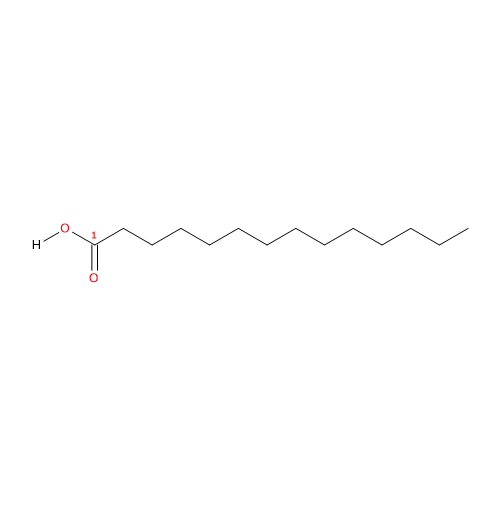Myristic acid (14 carbon atoms) was discovered by Playfair L. in 1841 in the nutmeg that is the seed of the tropical tree Myristica fragrans, from which its name.
It belongs to the group of saturated fatty acids (no double bond, so its shorthand notation is 14:0). It is also a member of the group called long chain fatty acids (LCFA), from 14 to 18 carbon atoms.
PROPERTIES
Molecular weight: 228.37092 g/mol
Molecular formula: C14H28O2
IUPAC name: tetradecanoic acid
CAS registry number: 544-63-8
11005

In purified form it is white solid insoluble in water, with melting point at 53.9 °C (129.02 °F; 327.05 K) and boiling point at 250 °C (482 °F; 523.15 K) at 100 mmHg.
OTHER NAMES
n-tetradecanoic acid
crodacid
n-tetradecoic acid
n-tetradecan-1-oic acid
1-tridecanecarboxylic acid
14:0
Food sources of myristic acid
It occurs, as glycerol ester, in most animal and vegetable fats and oils.
In animal fats, such as meat, eggs, milk, fish, shellfish, and crustacean fats, it is present in small quantities, <1.5 g/100 g of edible portion (maximum content: 1.4 g/100 g of edible portion in eel, and 1 g in herring).
The exception is represented by the fat in dairy products, such as:
- cheeses, especially the seasoned types (a good source is Parmigiano, with 3.4 g/100 g of edible portion);
- butter, the richest source, 8.3 g/100 g of edible portion.
Among vegetable fats and oils, a particularly rich source is coconut oil, with about 17 g/100 g of edible portion.
In the other vegetable oils, only palm oil has concentrations that reach 1 g/100 g of edible portion, whereas it does not exceed 0.86 g/100 g of edible portion in margarine (it is absent in peanut butter).
It should be noted that nutmeg butter is 75% trimyristin, the triglyceride of myristic acid (myristic acid predominates in the fats of the Myristicaceae).
In fruit, it is present in high amounts only in dried and fresh coconut, like lauric acid, 9.5 and 5.4 g/100 g of edible portion, respectively.
It is present in small amounts in a few cereals (maize, 0.28 g/100 g of edible portion, is the richest one).
It is absent in legumes.
Uses in cosmetics
It is used as an ingredient in soaps and shaving creams, often in the form of the esterester isopropyl myristate.
References
- Akoh C.C. and Min D.B. “Food lipids: chemistry, nutrition, and biotechnology” 3th ed. 2008
- Chow Ching K. “Fatty acids in foods and their health implication” 3th ed. 2008